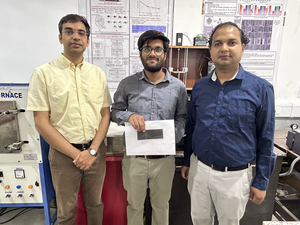IIT Mandi's new eco-friendly solution to shield from electromagnetic interference

Mandi, May 16 (IANS) Researchers at the Indian Institute of Technology (IIT) Mandi have developed a novel biodegradable and natural fibre-containing composite that can be used in electromagnetic interference (EMI) shielding, the institute said on Thursday.
Electromagnetic interference is a new form of pollution led by the proliferation of electronic devices. It can affect the functions of electronic systems across industries such as radar systems, military controls, and networking infrastructure. EMI shielding materials are essential to protect electronic devices and systems from EMI interference.
IIT Mandi’s new eco-friendly composite blend of kenaf fibre (known as Deccan Hemp/Ambari in local languages) and High-Density Polyethylene (HDPE), not only exhibits superior EMI shielding properties but is also recyclable.
Kenaf, known for its strength and low density as a natural fibre, acts as an optimal reinforcement material, augmenting the mechanical properties of the composite while diminishing its environmental impact. In addition, HDPE, a commonly used recyclable plastic, adds to the composite's eco-friendly characteristics.
The team added carbon nanotubes to make the composite an electrical conductor for EMI shielding.
The researchers incorporated carbon nanotubes (CNTs) to confer electrical conductivity to their composite. A blend of 16 per cent kenaf fibre and 5 per cent CNTs was found to exhibit superior EMI shielding, surpassing 30 dB, and exceptional mechanical strength.
"Cultivating a sustainable future demands innovation that enhances performance while minimising environmental impact. Our work in developing eco-friendly EMI shielding materials combines technological advancement with ecological responsibility," said Dr Himanshu Pathak, Associate Professor, School of Mechanical and Materials Engineering, IIT Mandi.
The application potential of this innovative composite material is vast, spanning from electronic equipment casing to overhead bins and unmanned aerial vehicles (UAVs), revealed the study, published in the journal Polymer Composites.
Disclaimer: This story has not been edited by the Sakshi Post team and is auto-generated from syndicated feed.





